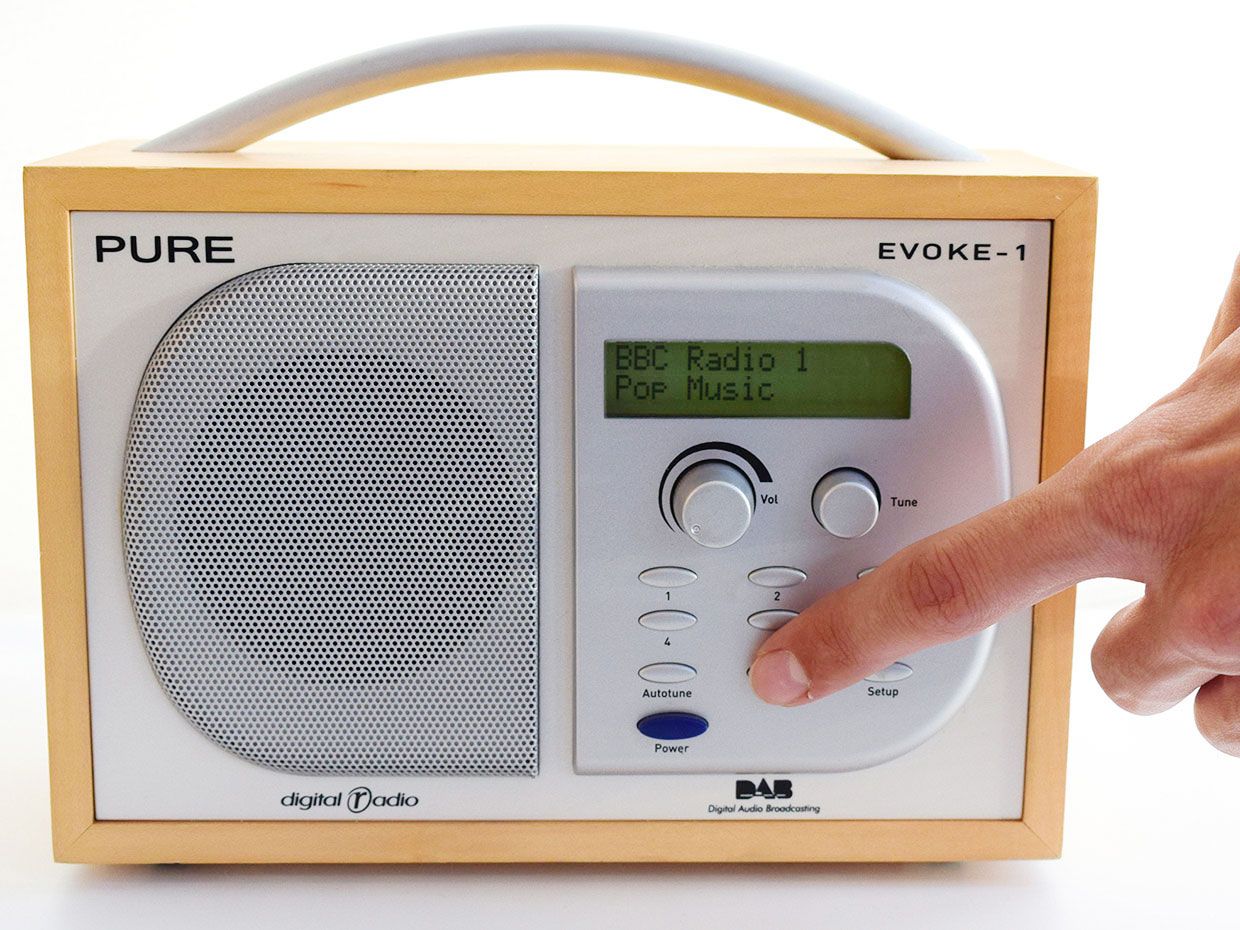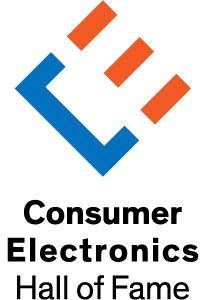The Consumer Electronics Hall of Fame: Pure Evoke-1 DAB Digital Radio
 Photo: Pure A Little DAB'll Do Ya: The Pure Evoke-1 was introduced in the United Kingdom in 2002, when radios designed for the Digital Audio Broadcasting (DAB) standard were still relatively uncommon. It was the first such radio to sell in large numbers and for less than 100.
Photo: Pure A Little DAB'll Do Ya: The Pure Evoke-1 was introduced in the United Kingdom in 2002, when radios designed for the Digital Audio Broadcasting (DAB) standard were still relatively uncommon. It was the first such radio to sell in large numbers and for less than 100.  Enter Here < Back to Consumer Electronics Hall of Fame
Enter Here < Back to Consumer Electronics Hall of Fame The replacement of analog media with digital formats began with recorded music in the early 1980s, and then progressed inexorably through recorded video, still photography, broadcast radio, and broadcast television. In Europe, digital broadcast radio began as a small research project in 1981, at the Institut fi1/4r Rundfunktechnik, in Munich. At roughly the same time, Japan began exploring digital television. The contrast between the two ostensibly similar projects is important: When consumer and broadcast companies in various countries began pursuing digital-TV technology, developing standards became as much a political process as it was a technological one. Radio, however, escaped that politicization, in large part because regional markets were content to adopt their own standards.
That was a plus early on, because it let developers sidestep the long and contentious standards wars that bogged down other technologies. But it was probably a net negative in the long run because it left global markets fragmented. While Europe stuck with its own digital-radio system, which is called Digital Audio Broadcasting (DAB) and European stations began using it in 1995, North American countries elected to pursue an entirely different technology. This American system, called HD Radio, is a proprietary technology created by iBiquity Digital Corp. The Federal Communications Commission selected HD Radio as the standard for the United States in 2002; to this day, any company that wants to market an HD Radio set or operate a radio station that broadcasts in the HD format has to pay fees to DTS Inc., which acquired iBiquity in 2015.
There were many good reasons for making broadcast radio digital. Most of them stem from one giant advantage: spectral efficiency. Any modulated radio signal has sidebands, swaths of spectrum that are higher and lower than the carrier frequency that are unavoidably created by the modulation process. These sidebands are particularly pronounced for FM. They reduce an FM signal's spectral efficiency, which is defined as the amount of information the signal can carry for a given amount of bandwidth. Because of data compression and other techniques, digital radio signals can have several times the spectral efficiency of analog FM ones. In both DAB and HD Radio, this spectacularly higher spectral efficiency means a huge amount of extra bandwidth. It's used to provide not just higher audio quality and supplementary program data, but also, in some cases, a couple of additional high-quality, stereo radio channels, all within the bandwidth formerly occupied by a single station's lower-quality analog signal.
The first radio station to adopt DAB was NRK Klassisk, in Norway, which began digital broadcast operations on 1 June, 1995. (Twenty-two years later, Norway would become the first country to cease all analog radio broadcasting in favor of digital.) Several other DAB stations, in England, Germany, and Sweden, followed within a few months. It nevertheless took several years for DAB to get popular. Part of the reason for the lag was the early radio sets themselves, which were clunky and expensive. In fact, it would be years before a company called Pure Digital would kick-start the DAB market with a compact, high-performance, and yet inexpensive radio called the Evoke-1.
The story starts with an English company with a different name: Imagination Technologies. It was then, as now, a developer of integrated circuits for video and audio processing. In 2000, it began selling a digital tuner IC but couldn't find any buyers among the big radio manufacturers. The IC's biggest advocate inside the company was CEO Hossein Yassaie, an Iranian-born engineer who had earned a Ph.D. at the University of Birmingham, in England, in the application of charge-coupled devices in sonar. He helped design and build a complete radio receiver that incorporated the chip to demonstrate its capabilities.
That radio, which bore the VideoLogic label, looked like almost every other rack stereo component at the time. It was a black rectangular box with a faceplate that was short and wide. The faceplate shared the same simple, elegant styling common to most audio equipment of the day.
In 2001, Imagination Technologies' radio operation, which by this point was also called VideoLogic, introduced what the company claims was the world's first portable digital radio. This one carried yet another new brand name: Pure. From a visual standpoint, the Pure DRX-601EX was very different from its predecessor, with a retro-tinged style. It stood upright, like an old-school lunchbox, and it had a blonde-oak finish. The triangular faceplate had a chrome finish evocative of a manta ray and took up only part of the front surface. Much of the front of the radio was a grille with rakishly slanted openings covering the speakers. The curved handle on top was solid, but nonetheless a visual reference to the plastic straps on the inexpensive transistor radios of the 1960s. It was striking visually, and it sounded great, but, at 499, it was not cheap.
What does all this have to do with the Evoke-1? We're getting there. Later that same year, 2001, VideoLogic got involved in a project with the BBC, which had been operating several DAB radio channels since 1995 and was eager to increase its audiences for them. The Digital Radio Development Bureau (DRDB), a trade organization that promoted DAB and was partly funded by the BBC, seized on the 100th anniversary of Marconi's first wireless transmission as a hook. With that in mind, the DRDB worked with VideoLogic to create a special commemorative edition DAB radio that it would sell for only 99. The radio hit the market late in 2001, and sold out rapidly. There was clearly growing demand for digital radio in the United Kingdom.
 Photo: Pure Retro, Restrained: The Pure Evoke-1 industrial design evoked the transistor radios of an earlier era.
Photo: Pure Retro, Restrained: The Pure Evoke-1 industrial design evoked the transistor radios of an earlier era. Emboldened by the brisk sales, in 2002, VideoLogic introduced the Pure Evoke-1. It shared the DRX-601EX's distinctive combination of blonde wood and brushed chrome, but with this model, the company seemed to tip the retro/modern balance toward the former. There was more brushed chrome on the face, and the single speaker was covered with a perforated screen reminiscent of the grilles on '60s transistor radios. The company also sold a separate speaker that could be plugged in to provide true stereo sound.
A year later it was still the only DAB radio on the market available for less than 100, according to a review in Radio Now, which praised the Evoke-1 for sounding "amazing" for a portable. "The radio is pretty sensitive-if there's a hint of signal the Evoke-1 will find it through its telescopic aerial," the review went on. The Evoke-1 ran only on mains power (the subsequent Evoke-2 would have built-in stereo speakers and also run on batteries).
The availability of the affordable Evoke-1 radios helped DAB finally take off in the United Kingdom. In 2003, the company claimed it was selling more than twice as many Evoke-1s as any competitive portable radio. In the ensuing years, hundreds of stations in Europe would switch to DAB, expanding the market. There are now over 40 countries with radio stations that conform to either the DAB standard, or its follow-on, called DAB+. The company said its cumulative DAB radio sales exceeded 5 million units as of 2014.
Along the way, Imagination's radio unit ditched the name VideoLogic and began calling itself Pure. Pure was successful selling its DAB radio ICs to other radio manufacturers, but eventually sales of its own Evoke radios began to decline. The Pure operation started losing money in 2009. In 2016, shortly after Yassaie stepped down as CEO, Imagination Technologies sold Pure to an Austrian investment operation called AVenture for a mere 2.6 million. Pure not only continues to make DAB+ radios, it claims it is still one of the leading sellers in the category.
And Yassaie? "In recognition of his services to technology and innovation," he was knighted by Elizabeth II, Queen of the United Kingdom, on New Year's Day in 2013. At the time, Imagination Technologies had market capitalization of 1 billion and was employing more than 1,300 people.
U.S. radio stations, by the way, began adopting HD Radio in 2003. In contrast to Europe, digital radio in the United States has been largely ignored by consumers, despite the existence of thousands of HD stations in the country. Proponents have attempted to popularize it by getting HD Radio receivers factory-installed in cars, with some success. This year, the percentage of cars with factory installed HD Radio reached 50 percent. However, by way of comparison, satellite radio (Sirius XM) is installed in 75 percent of cars sold in the United States.
Back to Consumer Electronics Hall of Fame >> < Back to Consumer Electronics Hall of Fame